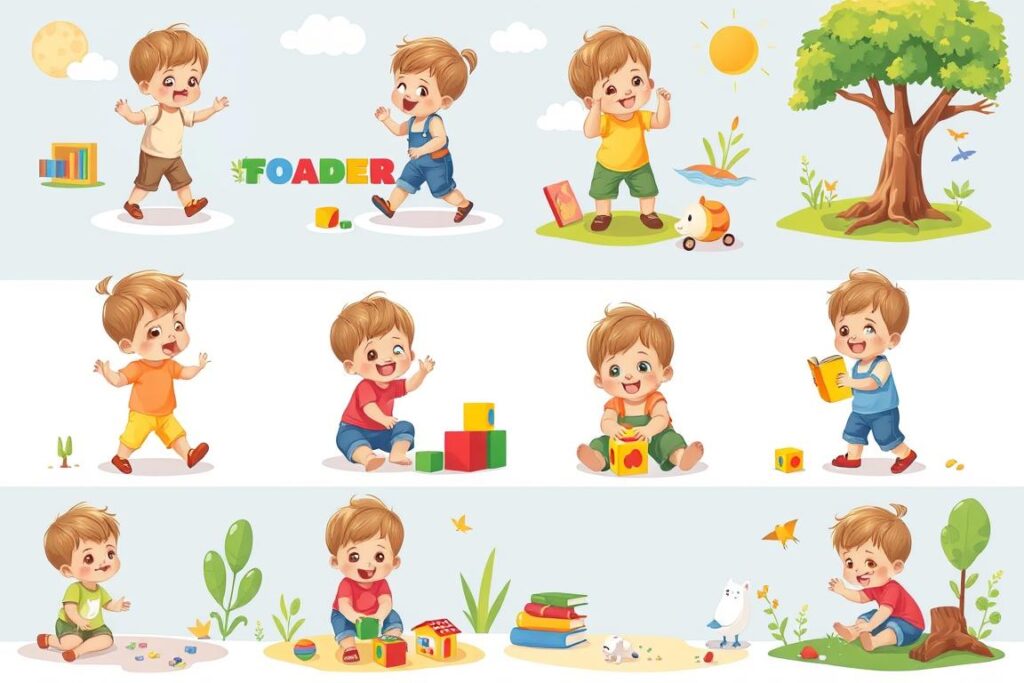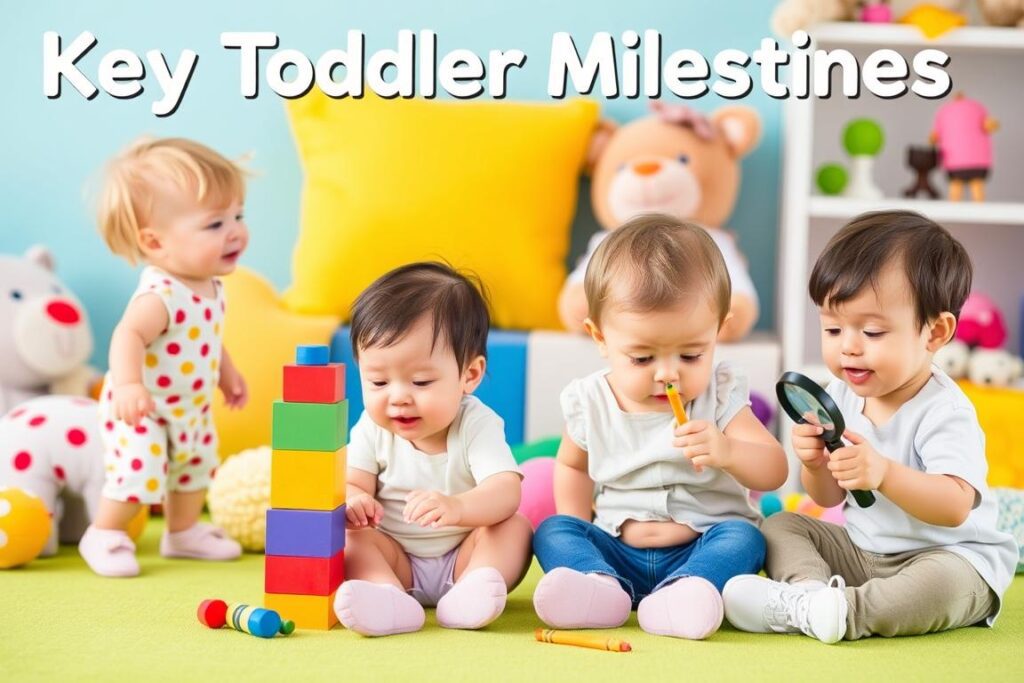Toddlerhood is a thrilling and changing time for kids. It lasts from 12 to 36 months and is full of big changes. Kids grow a lot in this time, getting better at moving, thinking, and feeling.
Knowing about toddlerhood helps parents and teachers help kids grow. It’s important to understand this stage to support kids well.
The toddler years are all about exploring and growing. Kids start to walk and talk, and they learn to be more independent. It’s a time of big discoveries and learning.
By knowing what happens in toddlerhood, we can help kids grow. We can give them the support they need to do well.
Key Takeaways
- Toddlerhood typically spans from 12 to 36 months of age, a critical period of rapid physical, cognitive, and social-emotional development.
- Understanding the toddler age range and associated milestones is essential for supporting healthy growth and meeting the unique needs of this vibrant age group.
- Toddlers undergo remarkable transformations, including the development of independence, language skills, and essential life-long abilities.
- Recognizing the key characteristics and transitions of toddlerhood allows parents, caregivers, and educators to provide the necessary guidance and support for children to thrive.
- Navigating the toddler years is a captivating journey that lays the foundation for future learning and social competence.
Understanding the Toddler Age Range
Toddlerhood is a time of fast growth in physical, mental, and social skills. It lasts from 12 to 36 months. During this time, toddlers hit many toddler milestones, go through developmental stages, and show certain toddler behavior.
Defining Developmental Milestones
Toddlers move from being babies to young children, hitting big milestones. They get better at moving, talking, solving problems, and handling their feelings. Watching these milestones helps parents see how their child is doing and how to help them grow.
Key Characteristics of Toddlerhood
Toddlers love to explore and be independent. They are very curious and learn through play. They also start to show their strong will, wanting to do things on their own and learning to control their feelings.
Age-Related Transitions
Toddlers go through big changes as they grow. They get better at moving, thinking, and feeling. Knowing about these changes helps parents and caregivers support them as they get ready for preschool.
“The toddler years are a time of remarkable growth and development, filled with both joyful discoveries and challenging behaviors.” – Dr. Jane Doe, child development expert
When Does Toddlerhood Begin?
The move from being a baby to a toddler is a big change. It usually happens between 12-18 months. At this time, kids start to move around and show more interest in the world.
One key sign of becoming a toddler is taking their first steps. Babies get better at moving and start walking. They might use furniture or a parent’s hand for support. This is the beginning of a fun time of learning and exploring.
Toddlers also start to talk more. Babies might just make sounds, but toddlers say simple words and phrases. They learn to tell others what they need and want.
- Typically, toddlerhood begins around 12-18 months of age
- First steps and increased mobility are hallmarks of the infant to toddler transition
- Emerging language skills, such as first words and simple phrases, also characterize the start of toddlerhood
As kids grow from babies to toddlers, they see more of the world. They become more independent in what they do and who they talk to. This is a time of great growth and learning.
Physical Development During Toddler Years
Toddlers grow a lot as they move from being babies to young children. They show big improvements in their big and small muscle skills. They also see big changes in toddler height and weight.
Gross Motor Skills Development
Toddlers get better at using their big muscles. They can walk, run, and climb stairs by the time they are two years old. This makes them feel more independent and curious.
Fine Motor Skills Progress
Toddlers also get better at using their small muscles. They can hold things, play with toys, and even draw. This lets them be more creative and solve problems.
Growth Patterns and Expectations
Toddlers usually grow taller and heavier at a steady rate. They might grow 5 inches and gain 5 pounds each year. But, every child grows differently because of their genes, diet, and health.
“Watching a child’s physical development is like witnessing a miraculous transformation. Each new milestone is a testament to the incredible capabilities of the human body.”
Cognitive Development in Toddlers
Toddlers start a journey of toddler brain development with big steps in their thinking. They learn to solve problems and start toddler learning. These skills are the start of their future in school and thinking.
Toddlers get better at solving problems. They use their growing skills to face daily challenges and explore. This helps them understand the world and improves their thinking.
Memory and imagination also grow a lot in toddlers. They remember past things better and imagine new ones. This shows how much they can learn and explore.
Toddlers become very curious and want to learn more. They ask lots of questions and try to understand everything. This curiosity is key for their future in school and love of learning.
“The early years of a child’s life are a critical period for brain development, laying the foundation for future learning and success.”
Knowing how toddlers think helps parents and caregivers support them. It sets them up for a life full of learning and success.
Social and Emotional Growth Stages
Toddlers grow a lot as they explore the world. This time is key for building future relationships and learning to control their feelings.
Emotional Regulation Development
Toddlers face intense emotions that can change quickly. They start to understand and manage their feelings with help from caregivers. This leads to better toddler emotions and self-awareness.
Social Interaction Milestones
Toddlers start to enjoy playing with others more. They learn to share, take turns, and play simple games. This is the start of their social skills and friendships.
Attachment and Independence
Toddlers balance being close to their caregivers and wanting to be independent. They test limits and show they can do things on their own. This journey helps them find their identity and gain confidence.
| Emotional Regulation | Social Interaction | Attachment and Independence |
|---|---|---|
| – Recognizing and expressing emotions – Developing self-control – Understanding and communicating feelings |
– Engaging in cooperative play – Sharing and taking turns – Participating in social games |
– Forming strong bonds with caregivers – Exploring independence and autonomy – Navigating the balance between attachment and independence |
“The toddler years are a crucial time for social and emotional development, laying the foundation for future relationships and self-regulation.”
Language Development Through Toddler Years
Toddlers grow and their language skills bloom, showing the amazing toddler speech development and language acquisition during this key time. They start with their first words and move to simple sentences. It’s an exciting journey of early communication.
Children usually say their first words around 12 months old. This is the beginning of a fast growth in their vocabulary. By 24 months, most toddlers know over 300 words, a big step in language development.
Toddlers start combining words into short phrases like “Daddy bye” or “More juice.” This is a big step in language acquisition. It helps them express their needs and thoughts more clearly, deepening their connection with others.
Toddlers also get better at understanding and following simple instructions. They start to have conversations and even ask questions. These achievements show how much they are growing in both mind and social skills during the toddler years.
Remember, every toddler develops at their own pace. This can be influenced by genetics, environment, and early experiences. But the journey of toddler speech development is always fascinating and crucial for their growth.
“The development of language is part of the development of the child, as all learning is embedded in the child’s physical and social experience, his gestures, his activity, his senses.”
– Maria Montessori
Behavioral Changes and Challenges
Toddlers go through many changes as they grow. Toddler tantrums, defiance, and other issues are common. Knowing these behaviors and using the right discipline techniques helps parents manage these ups and downs.
Common Behavioral Issues
Toddlers are strong-willed and want to be independent. They often face issues like:
- Frequent tantrums and outbursts
- Defiance and refusal to follow instructions
- Difficulty sharing and cooperating with others
- Aggressive behaviors such as hitting, biting, or pushing
Positive Discipline Strategies
Handling these challenges needs a gentle, consistent, and positive approach. Good discipline techniques for toddlers include:
- Setting clear rules and boundaries
- Using positive reinforcement to encourage good behavior
- Redirecting the child’s attention to more constructive activities
- Practicing patience and empathy during emotional outbursts
- Encouraging the toddler to express their feelings in a healthy way
Setting Age-Appropriate Boundaries
It’s important to set boundaries that fit the toddler’s age. This means:
- Clearly communicating expectations and consequences
- Consistently enforcing rules and following through with consequences
- Providing structured routines and schedules to promote stability
- Offering choices within set limits to foster the toddler’s sense of control
By understanding these issues, using positive discipline, and setting the right boundaries, parents can help their toddlers. They can teach them to handle challenges and develop good behaviors.
| Behavioral Issue | Positive Discipline Technique |
|---|---|
| Tantrums | Remain calm, validate feelings, and redirect attention |
| Defiance | Offer choices, use positive reinforcement, and set clear expectations |
| Aggression | Teach conflict resolution skills, model empathy, and establish consequences |
Signs Your Child is Leaving Toddlerhood
As your child grows, you’ll see them move from toddlerhood to preschool years. One big change is in their physical skills. Preschoolers can balance better, move more smoothly, and handle small things with ease.
They also think more deeply and can focus longer. They ask harder questions, solve problems better, and enjoy learning more. Plus, they start to play and work with others more.
Seeing these signs means your child is entering a new exciting phase. Supporting their growth will help them adjust well to preschool.
FAQ
What is the typical age range for toddlerhood?
Toddlerhood is from 12 to 36 months old. This is about 1 to 3 years.
What are the key developmental milestones during the toddler years?
Toddlers make big strides in many areas. They improve in moving, talking, thinking, and feeling.
How do toddlers’ physical abilities progress during this stage?
Toddlers get better at moving around. They learn to walk, run, and climb. They also get better at using their hands for small tasks.
What are some common behavioral challenges during toddlerhood?
Toddlers may throw tantrums and be stubborn. They struggle with controlling their feelings. Caregivers need to use positive ways to teach them.
How does language development progress in toddlers?
Toddlers quickly learn new words and start making simple sentences. They move from saying their first words to more complex ones.
What are the signs that a child is transitioning out of the toddler stage?
As they get closer to preschool, kids become more independent. They solve problems better and play with others more. This shows they’re leaving the toddler stage behind.









2 thoughts on “Toddler Age Range: When Does Toddlerhood Start and Stop?”